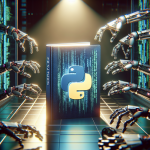
Why Python Remains a Top Choice in AI Development
Why Python Remains a Top Choice in AI Development
Python, a language conceived in the late 1980s, has maintained an enduring appeal among developers, particularly in the field of Artificial Intelligence (AI). Its longevity and sustained relevance underscore its importance in programming, especially given the dynamic nature of technology. In this article, we will explore the reasons behind Python’s popularity in AI development.
Ease of Use and Readability
Python’s simple syntax and readability make it easy for beginners and experts alike to understand and work with. Its structure minimizes language complexity, allowing developers to focus on what really matters — solving problems. As a result, this simplicity supports quick prototyping and iteration, crucial aspects in developing AI solutions.
Extensive Libraries and Frameworks
Python boasts a rich ecosystem of libraries and frameworks designed specifically for AI and machine learning. Libraries like TensorFlow (Official site) and PyTorch (Official site) offer powerful tools for building robust AI models. Additional resources, such as NumPy and SciPy, bolster Python’s capabilities in data manipulation and complex mathematical computations.
A Vibrant Community
One of Python’s strongest assets is its large and active community. This community contributes to a shared pool of knowledge and resources, often resulting in robust community-driven updates and enhancements. Tutorials, forums, and Q&A sites ensure that developers at all levels can find the help and support they need readily.
Deep Learning and Beyond
Deep learning, a subset of machine learning, has been heavily influenced by frameworks developed in Python. Projects such as Keras simplify the creation of neural networks, allowing for experimentation at unprecedented scales. Given these capabilities, it is unsurprising that Python powers many cutting-edge AI applications today.
Integration Capabilities
Python’s flexibility means it integrates well with other languages and technologies. For data processing tasks, developers can seamlessly combine Python with languages like C or Java. This capability is particularly useful in enterprise settings where multiple systems need to interact efficiently.
Conclusion
In the fast-evolving world of AI development, Python’s adaptability, extensive library support, and vibrant community have anchored its position as a leading programming language. As more innovations emerge, Python appears poised to adapt and grow, maintaining its relevance in the technological landscape.











